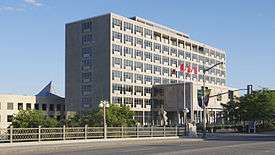John G. Diefenbaker Building
The John G. Diefenbaker Building is a building in the New Edinburgh neighbourhood of Ottawa, Ontario. The building served as Ottawa's city hall from August 2, 1958 to January 1, 2001, and is commonly known as Old City Hall. Purchased in 2003 by the Government of Canada, it was known by its municipal address, 111 Sussex Drive, until September, 2011 when it was renamed after Canada's 13th prime minister, John Diefenbaker.[1][2]

Construction
The building is located on Green Island at the point where the Rideau River empties into the Ottawa River. The historic city hall on Elgin Street had been destroyed by a fire in 1931. For the next 27 years the city operated out of temporary offices in the Transportation Building. The International Style building was opened on August 2, 1958 by Princess Margaret as a member of the Canadian Royal Family. It is noted for being the first building in Ottawa to be fully air conditioned. It was designed by John Bland of the firm Rother, Bland and Trudeau and is considered one of the most important International Style buildings in Canada, winning the Massey Medal for design in 1959. The original drawings for the building are held at the McGill University Library Special Collections as part of the John Bland Archive.
City hall expansion
In 1988 Ottawa mayor Jim Durrell initiated a controversial[3] scheme to expand the building, quadrupling its original size. Architect Moshe Safdie was chosen for the redesign, carried out in 1992-93. Conflict soon broke out between Safdie and the city.[4] Safdie demanded a higher fee and delayed the project for several months before the city acquiesced to his demand. Then a conflict broke out over a pair of eighteen story observation towers. City council voted to cut the towers to save the million dollars they cost. This infuriated Safdie who felt the towers were essential to the design. The panel that picked the design had singled out the tower as one of the highlights of the design. Eventually the city compromised and a bare scaffold was erected.
The new building caused considerable controversy in the city with some liking the design, but others seeing the $72 million structure a waste of money. The building was much larger than the city needed and for several years large sections were vacant. In 1999 offices were rented out to Global Affairs Canada, which is based nearby, and this mostly filled the building.
Federal government ownership
On January 1, 2001, Ottawa was amalgamated with Cumberland, Gloucester, Goulbourn, Kanata, Nepean, Osgoode, Rideau, Rockcliffe Park, Vanier and West Carleton. It was decided that the new city would be based at 110 Laurier Avenue West. This building was considerably smaller but more centrally located. In 2003 the Old City Hall was sold to the federal Public Works department. Today the building mainly houses Global Affairs employees. For several months it was also the site of the Gomery Inquiry hearings.
See also
| Wikimedia Commons has media related to John G. Diefenbaker Building. |
- First City Hall (Ottawa), city hall from 1849–1877
- Second City Hall (Ottawa), city hall from 1877–1931
- Transportation Building (Ottawa), 1931 the building became Ottawa's temporary city hall
- Ottawa City Hall, city hall since 2001
References
- "Old city hall renamed to honour John Diefenbaker". Ottawa Citizen. Retrieved 19 September 2011.
- "Government of Canada Names the 111 Sussex Drive Building Complex in Honour of Prime Minister John George Diefenbaker". Canada News Centre. Public Works and Government Services Canada. Retrieved 19 September 2011.
- Deachman, Bruce (19 August 2015). "Islands of Ottawa: Green Island a historical microcosm of the city". Ottawa Citizen. Retrieved 27 September 2017.
- Egan, Kelly (16 September 2016). "Egan: We're a government town — of course we hate edgy architecture". Ottawa Citizen. Retrieved 27 September 2017.